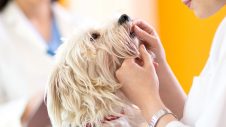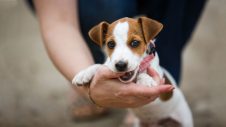Destructive Chewing
Chewing is a normal and necessary behaviour for your puppy. However, can be frustrating if your dog decides to chew your favourite shoes. Chewing is an important behaviour to a dog’s health. These are some of the reasons a dog needs to chew.
Teething
Puppies experience teething for up to 12 months of age. During this time, their jaw can be uncomfortable and tender. Chewing can release the discomfort and is important for the development of their jaw and gums.
Exploring
Dogs use their mouths to get information about the texture, taste, and size of objects in their environment.
Play
Puppies chew things up because they think it’s fun. Gnawing, shaking, and tearing action used in play is practice for adult behaviour. Play chewing is essential to development.
Boredom
If your dog has not been provided with stimulation, they may go looking for something to do. Chewing can be mentally stimulating for a dog, especially if the objects vary in texture, taste, and shape.
Attention seeking
A dog may repeatedly chew up objects in front of their owner because they enjoy the reaction. Being chased by an angry human can create excitement. Your dog may treat this like a game, which reinforces the action.
Nutrition gaps
If dogs are hungry or lacking in a particular nutrient, they are more likely to experiment with chewing inappropriate objects in an attempt to find something to eat.
In general, puppy chewing can be managed with prevention, providing opportunities to chew, and handling errors correctly.
Prevention
- don’t allow your dog access to things you don’t want chewed – put them away
- when your pup can’t be directly supervised, confine them to an area where they can’t chew the wrong things
- feed your puppy on a premium diet to ensure their nutrition needs are being met
- keep your puppy mentally stimulated with appropriate toys
- provide controlled opportunities to chew
- choose high-quality chew toys that are not easily destroyed
- toys for your pup should vary in taste, texture, and size, and be rotated on a daily basis. They should not be left lying around as the pup will get bored with them rapidly.
- don’t give your old belongings (e.g. shoes) to your pup to chew – they don’t know the difference between new and used
- teach your dog how to use chew toys. Make them tasty by smearing with food. Play tug and chase with these toys to increase the appeal of them
Suggested chew items
- durable rubber toys
- hollow toys to stuff with food
- rolling and bouncing toys to chase
- synthetic and nylon chew bones
- rawhide chews
To ensure the safety of your pet we recommend supervising your pet when chewing on all of the above items.
When your dog makes a mistake
Avoid punishing your dog. Positive reinforcement of good behaviour works better than punishment of the wrong behaviour. Put items that you don’t want your dog to chew out of their reach.
If your dog is chewing things like furniture, consider a non-toxic, pet-friendly deterrent. Bad tasting products that you can safely paint a chair leg with, for example, may deter your dog from chewing this item again.
To interrupt your dog chewing on the incorrect item, simply use a firm ‘no’ and take the object away. Offer your dog an appropriate chew toy instead. You delay the exchange to reduce the chance of the pup thinking it is being rewarded for chewing.
If you have serious concerns about your dog’s dental health, or their chewing behaviour, contact your local Greencross Vets.

 Greencross Vets
Greencross Vets 





